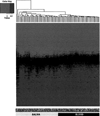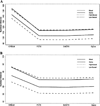DNA extracted from saliva for methylation studies of psychiatric traits: evidence tissue specificity and relatedness to brain
- PMID: 25355443
- PMCID: PMC4610814
- DOI: 10.1002/ajmg.b.32278
DNA extracted from saliva for methylation studies of psychiatric traits: evidence tissue specificity and relatedness to brain
Abstract
DNA methylation has become increasingly recognized in the etiology of psychiatric disorders. Because brain tissue is not accessible in living humans, epigenetic studies are most often conducted in blood. Saliva is often collected for genotyping studies but is rarely used to examine DNA methylation because the proportion of epithelial cells and leukocytes varies extensively between individuals. The goal of this study was to evaluate whether saliva DNA is informative for studies of psychiatric disorders. DNA methylation (HumanMethylation450 BeadChip) was assessed in saliva and blood samples from 64 adult African Americans. Analyses were conducted using linear regression adjusted for appropriate covariates, including estimated cellular proportions. DNA methylation from brain tissues (cerebellum, frontal cortex, entorhinal cortex, and superior temporal gyrus) was obtained from a publically available dataset. Saliva and blood methylation was clearly distinguishable though there was positive correlation overall. There was little correlation in CpG sites within relevant candidate genes. Correlated CpG sites were more likely to occur in areas of low CpG density (i.e., CpG shores and open seas). There was more variability in CpG sites from saliva than blood, which may reflect its heterogeneity. Finally, DNA methylation in saliva appeared more similar to patterns from each of the brain regions examined overall than methylation in blood. Thus, this study provides a framework for using DNA methylation from saliva and suggests that DNA methylation of saliva may offer distinct opportunities for epidemiological and longitudinal studies of psychiatric traits.
Keywords: EWAS; HumanMethylation450; biomarker; epigenetic; oragene.
© 2014 Wiley Periodicals, Inc.
Figures




Similar articles
-
Characterization of cross-tissue genetic-epigenetic effects and their patterns in schizophrenia.Genome Med. 2018 Feb 26;10(1):13. doi: 10.1186/s13073-018-0519-4. Genome Med. 2018. PMID: 29482655 Free PMC article.
-
Cross-tissue correlations of genome-wide DNA methylation in Japanese live human brain and blood, saliva, and buccal epithelial tissues.Transl Psychiatry. 2023 Feb 27;13(1):72. doi: 10.1038/s41398-023-02370-0. Transl Psychiatry. 2023. PMID: 36843037 Free PMC article.
-
Genome-wide DNA methylation comparison between live human brain and peripheral tissues within individuals.Transl Psychiatry. 2019 Jan 31;9(1):47. doi: 10.1038/s41398-019-0376-y. Transl Psychiatry. 2019. PMID: 30705257 Free PMC article.
-
DNA methylation-based age prediction from saliva: High age predictability by combination of 7 CpG markers.Forensic Sci Int Genet. 2017 Jul;29:118-125. doi: 10.1016/j.fsigen.2017.04.006. Epub 2017 Apr 9. Forensic Sci Int Genet. 2017. PMID: 28419903
-
Birthweight DNA methylation signatures in infant saliva.Clin Epigenetics. 2021 Mar 19;13(1):57. doi: 10.1186/s13148-021-01053-1. Clin Epigenetics. 2021. PMID: 33741061 Free PMC article.
Cited by
-
Lack of Methylation Changes in GJB2 and RB1 Non-coding Regions of Cochlear Implant Patients with Sensorineural Hearing Loss.Acta Med Philipp. 2023 Sep 28;57(9):116-120. doi: 10.47895/amp.v57i9.5200. Acta Med Philipp. 2023. PMID: 37990697 Free PMC article.
-
Telomere length measurement by qPCR - Summary of critical factors and recommendations for assay design.Psychoneuroendocrinology. 2019 Jan;99:271-278. doi: 10.1016/j.psyneuen.2018.10.005. Epub 2018 Oct 10. Psychoneuroendocrinology. 2019. PMID: 30343983 Free PMC article. Review.
-
Association of Epigenetic Differences Screened in a Few Cases of Monozygotic Twins Discordant for Attention-Deficit Hyperactivity Disorder With Brain Structures.Front Neurosci. 2022 Jan 21;15:799761. doi: 10.3389/fnins.2021.799761. eCollection 2021. Front Neurosci. 2022. PMID: 35145374 Free PMC article.
-
Characterization of methylation patterns associated with lifestyle factors and vitamin D supplementation in a healthy elderly cohort from Southwest Sweden.Sci Rep. 2022 Jul 25;12(1):12670. doi: 10.1038/s41598-022-15924-x. Sci Rep. 2022. PMID: 35879377 Free PMC article.
-
Neonatal NR3C1 Methylation and Social-Emotional Development at 6 and 18 Months of Age.Front Behav Neurosci. 2019 Feb 5;13:14. doi: 10.3389/fnbeh.2019.00014. eCollection 2019. Front Behav Neurosci. 2019. PMID: 30804765 Free PMC article.
References
-
- Aberg KA, McClay JL, Nerella S, Clark S, Kumar G, Chen W, Khachane AN, Xie L, Hudson A, Gao G, Harada A, Hultman CM, Sullivan PF, Magnusson PK, van den Oord EJ. Methylome-wide association study of schizophrenia: Identifying blood biomarker signatures of environmental insults. JAMA Psychiatry. 2014;71(3):255–264. - PMC - PubMed
-
- Beyan H, Down TA, Ramagopalan SV, Uvebrant K, Nilsson A, Holland ML, Gemma C, Giovannoni G, Boehm BO, Ebers GC, Lernmark A, Cilio CM, Leslie RD, Rakyan VK. Guthrie card methylomics identifies temporally stable epialleles that ate present at birth in humans. Genome Res. 2012;22(11):2138–2145. - PMC - PubMed
Publication types
MeSH terms
Substances
Grants and funding
- R56 MH071537/MH/NIMH NIH HHS/United States
- K01 MH085806/MH/NIMH NIH HHS/United States
- R01 MH071537/MH/NIMH NIH HHS/United States
- R01 MH096764/MH/NIMH NIH HHS/United States
- MH071537/MH/NIMH NIH HHS/United States
- MH085806/MH/NIMH NIH HHS/United States
- R01 HD071982/HD/NICHD NIH HHS/United States
- HD071982/HD/NICHD NIH HHS/United States
- HHMI/Howard Hughes Medical Institute/United States
- R01 MH094757/MH/NIMH NIH HHS/United States
- 281338/ERC_/European Research Council/International
- MH096764/MH/NIMH NIH HHS/United States
LinkOut - more resources
Full Text Sources
Other Literature Sources
Molecular Biology Databases

